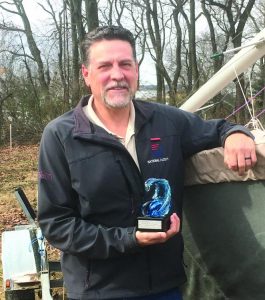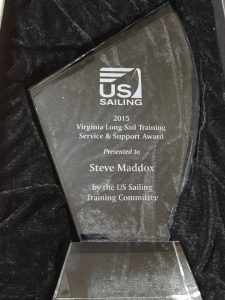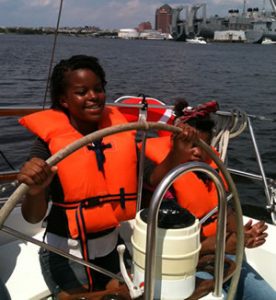Stay up-to-date with SeaAffinity
You can read about what is going on with us – present, past, and future! Check back here often, to get all the news.
Steve Maddox Awarded the Larr

January 31, 2019
Maddox is well-known and respected around the Chesapeake as the force behind SeaAffinity, a Baltimore-based, non-profit sailing organization that seeks to challenge youth and adults, including those impacted by disabilities, to develop life skills and realize their full potential through water-related experiences.
However, some Chesapeake sailors may not be aware that Maddox is also a member of U.S. Sailing’s training committee, where he oversees U.S. Sailing’s regional training coordinators. In addition to his work at the national level, Maddox runs multiple courses around the U.S., providing instructor training to hundreds of sailors and annually.
Maddox says, “It was Mike Mueller that first opened the door to U.S. Sailing for me. At his encouragement, I pursued more training and involvement across U.S. Sailing venues. I became a keelboat instructor, a smallboat instructor trainer, a coach trainer, and a powerboat instructor trainer. I was recruited to National Faculty, the group of volunteers that develop and write the training materials. In addition, I serve as a powerboat master instructor trainer and on U.S. Sailing’s training committee. While I am honored to receive this award, it is really the great staff and volunteers that keep me serving.”
In making the award, U.S. Sailing recognized Maddox as “a valuable member of the training committee, whose calm demeanor, attention to detail, and keen understanding of students’ needs have earned him respect among his peers.”
The Timothea Larr Trophy is awarded to a person whose vision and guidance have made an outstanding contribution to the advancement of sailor education in the United States. The award may be made to any individual who, in the opinion of the U.S. Sailing training committee selection team, fully meets this criterion. The trophy is the training committee’s highest honor, and is awarded annually at the national conference. Nominees must be members of U.S. Sailing and embody the highest principles of honor, integrity, and selfless dedication to the sport.
From May 13, 2019 SpinSheet magazine
Steve Maddox awarded US Sailing’s “Ginny”

February 5, 2016
Steve Maddox has devoted countless hours to helping US Sailing improve its curriculums. He has authored publications, developed tests, helped create policy and worked to develop consensus among a wide array of subject matter experts. He is universally respected and has served as the change agent for sailing instruction at both the national and regional levels.
For many years he worked tirelessly to make Downtown Sailing Center in Baltimore, Md. one of the top community sailing centers in the country. More recently, he has dedicated his efforts to SeaAffinity, a life skills development organization that uses sailing and boating education as a platform for challenging and enabling youth and adults to realize their potential, including those impacted by disabilities.
Steve is a Regional Training Coordinator, a Powerboat Training Coordinator, and a member of the Training Committee. He has been an Instructor Trainer for countless new instructors in both the Powerboat and Smallboat tracks and his ability to inspire, while providing constructive feedback, is unparalleled.
Beyond just his involvement with US Sailing, Steve has committed himself to helping people experience sailing, regardless of ability. He focuses on the education, not the financials. No child is ever turned away from SeaAffinity because they can’t pay and, through his partnerships with organizations like the Boys and Girls Club of Metropolitan Baltimore, he’s been able to expose kids to sailing that might otherwise not had the chance.
Read more about US Sailing’s awards here
SeaAffinity in Caribbean Compass

November 2015
SEA AFFINITY
According to Steve Maddox, who started a program in his Baltimore, Maryland area to serve under-privileged urban youth, “Sailing is a platform for higher life functioning.” He had home-schooled his own children, and then began assisting other parents who were home-schooling, when Maddox stumbled upon US Sailing’s Reach program. It “utilizes sailing as an educational platform, challenging youth to embrace education, establishing a love of learning while exploring productive Science, Technology, Engineering and Math” according to www.reach.ussailing.org.
Maddox amended Reach modules to make them work with non-sailors and the “learning different”, as he prefers to call children who are learning disabled. Although Baltimore children are located within two miles of the sea, most never go there and have no affinity for the sea. Because of transportation costs, initially Maddox took the program to the kids instead of the kids to the water. He used videos, talked concepts and offered the program at no charge. What he found out was remarkable.
The dynamics of his first “no charge” after-school program administered through Boys & Girls Clubs (a national association serving inner-city kids) were these: parents dropped kids off (the children had no choice in attendance), kids were given “stuff” (food, etcetera), kids stayed indoors fiddling around on computers. The result: kids were restless and disrespectful.
Later, Maddox tried a different format within a Christian after-school program. Here the kids walked to the facility (by choice), they were not given “stuff”, they played outside, they worked in small groups (six kids/one adult), there were behavioral rules such as “raise your hand before talking”, the kids were expected to write things down, computer time was limited, there was a minimal cost to attend. All these factors yielded the results Maddox and others hoped for. The kids were respectful. Time was productive.
Each lesson taught had to bring relevance. A sample of some of the lessons: hoisting sails, steering, picking up marine debris (they scooped up trash while sailing and later talked about where it came from and how kids can help reduce trash and prevent littering).
Building an affinity for the sea in turn builds appreciation. Where there is appreciation, there is understanding. Where there is understanding, there is caring. Caring and a high regard for the sea are two of junior sailing’s many benefits.
Youth2Adult – Y2A – is a series of articles celebrating sailing’s role in youth development.
Article by ELLEN EBERT BIRRELL Originally published in November 2015 Caribbean Compass
HOW SEAAFFINITY OF BALTIMORE IMPLEMENTED REACH
 September 11, 2013
September 11, 2013
US Sailing interviewed SeaAffinity Director Steve Maddox recently to learn and share creative ways educational programs are successfully implementing the REACH program . REACH utilizes sailing as an educational platform, challenging youth to embrace education, establish a love of learning and explore productive Science, Technology, Engineering, and Math (STEM) based careers.
Sea Affinity is a perfect match for REACH. They are a life skills development organization that uses sailing and boating education to challenge and enable youth and adults, including those impacted by disabilities, to realize their potential.
Organizations interested in utilizing the REACH program should use this interview as resource and a model.
US Sailing: How did SeaAffinity partner with the Boys and Girls Club of Metro Baltimore to implement REACH?
Steve Maddox: We had already decided to use REACH for Sea Affinity’s spring home school Sailing into STEM program and believed that it would be a great part of an outreach program. During the NSPS (National Sailing Program Symposium), we learned how other programs had partnered with their local Boys and Girls Clubs and were empowered by Wayne Moss’ (Boys and Girls Clubs of America) keynote address. When we returned from NSPS, we sent an email to B&G Clubs of Metro Baltimore asking for an opportunity to discuss the program. Ken Darden, president and CEO, was open about it and set up a meeting with us, including Jeff Johnson, vice president of operations, and Matt Justus, director of programing. We offered to run an after school pilot program at no cost once a week for five weeks. We met with Matt again to review the curriculum and to work out dates for the program.
US Sailing: Describe the characteristics of the students you were working with.
Steve Maddox: The students we are working with through the Boys and Girls Clubs attend Maree G. Farring Elementary/Middle School. Ninety-one percent of the students in that school receive reduced lunch, and 17.9 percent are habitually truant. The results of the MSA testing of the sixth grade showed 62 percent of the students were on grade level for reading and 67.4 percent for math. The fifth grade MSA scores showed 38.1 percent were on grade level for science.
The students are placed in the program instead of choosing to participate. Typically, these students show little to no respect for others as evidenced by their talking out of turn, name calling and use of cell phones during the program. Even when these students are interested and know the right answer, they don’t want to show it. There seems to be a perception that it is not cool to be smart.
US Sailing: What were some of the biggest challenges for instructors when implementing REACH?
Steve Maddox: For our initial after school program, the biggest challenge was keeping their attention. The students had been in a classroom all day and we were trying to ‘teach them more stuff’. We had to have a lot less sitting and a lot more doing.
We also found that the kids had a little trouble relating to anything outside of their environment. These students had little to no previous exposure to sailing.
We also had some trouble with finalizing scheduling and collecting paperwork (releases and waivers) from the parents and the facility.
US Sailing: Transportation can be a big financial hurdle for sailing centers looking to partner with youth organizations and schools. How did Sea Affinity handle this challenge?
Steve Maddox: We found it was much easier to transport ourselves to them then to provide transportation for them. For the initial sessions, we went into their facility and taught the modules there with the goal of having them come to us to sail for the last session. Obviously, the modules had to be modified since we couldn’t complete the sailing aspect at their facility. We held the sailing out as a carrot to incentivize the students. For the final session, the B&G Clubs used their van to bring the kids to us. This was the only expense that the clubs had to bear.
US Sailing: In your opinion, what was the biggest impact of the Reach program for the kids of inner city Baltimore?
Steve Maddox: The biggest impact seemed to be that fact that we were there. The kids saw that people from outside their environment came to them and spent time with working with and listening to them – just showing that someone cared. We did hear that the STEM skills we taught did help in their classroom work.
We also heard that they felt new career possibilities were opened to them.
US Sailing: What are you plans to implement REACH moving forward?
Steve Maddox: Matt Justus is extremely excited about the program. He wants us to offer it to all of their locations on an ongoing basis. We ran a modified program for their summer day program and currently have plans to run the program at several of their locations this fall.
We are also using the Reach in our fall home school Sailing into STEM program.
Originally published by US Sailing
